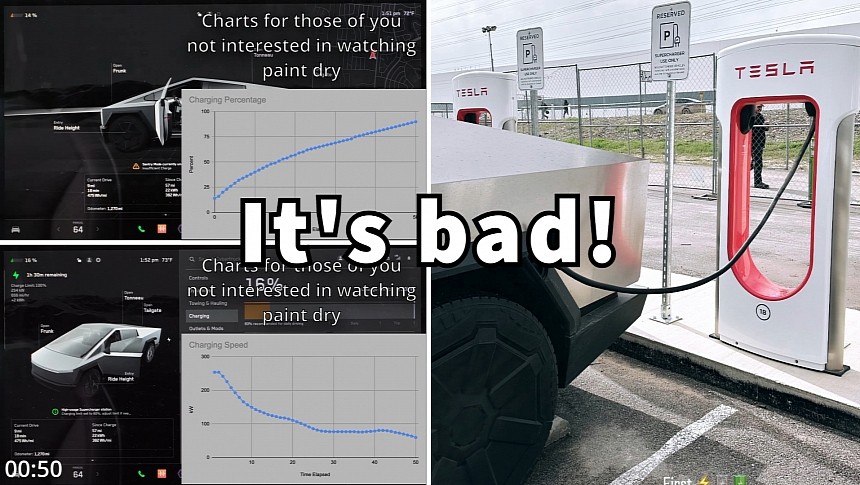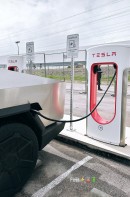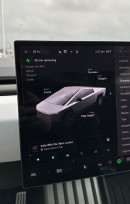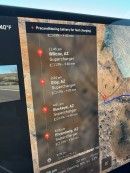Ever since the Tesla Cybertruck was spotted charging, people suspected that Tesla's 4680 cells were as bad as they were on the Model Y. The first documented Cybertruck charging curve confirms this, showing that the Tesla Cybertruck spends a lot of time charging.
The Cybertruck is the first Tesla model that uses 4680 cells exclusively. Tesla made sure it had enough 4680-cell supply by discontinuing the 4680 Model Y produced at Giga Texas until earlier this year. The Model Y was crippled by poor battery performance, requiring more time to charge than its 2170-cell counterpart made in Fremont. This was caused by the charging power dropping very early into the charging session. Tesla's charging time estimates were also too optimistic, claiming it needed 25 minutes to reach 80% when, in fact, it required 40 minutes.
Tesla reassured those who feared the Cybertruck would experience the same issue that the electric pickup uses a more advanced variant of the 4680 cells. The second generation of the cells, dubbed "Cybercells," promised 10% more energy density, but Tesla didn't offer estimates about its charging performance. The first Cybertrucks seen charging pointed to similar problems as the Model Y, but without having a full charging curve, it wasn't easy to draw a conclusion.
Before Christmas, a Cybertruck charging at a V3 Supercharger station was spotted drawing only 148 kW at 35% state of charge (SoC), which was considered abysmal. Other Teslas draw at least 200 kW at a similar state of charge. The estimated time until it reached the 80% limit was 35 minutes, again, not impressive. Tesla fans told those who pointed out these shortcomings that the Cybertruck was likely hooked up to a less powerful Supercharger V2 charger.
Others said that the Cybertruck might be optimized for 800-volt chargers and is not that good at charging on a 400-volt Supercharger. That shouldn't be the case, considering that Tesla uses the same series-parallel trick as GM to charge the battery at both 400-volt and 800-volt without needing an inverter. By now, more people suspected that the Cybertruck was as bad at supercharging as the skeptics said it was.
On Friday, one of the early Cybertruck owners shared details from their road trip. According to the screenshots he posted showing the plotted Supercharger stops and the recommended charging duration, things weren't looking well. The Cybertruck wanted to charge around 40 minutes, and sometimes even 55 minutes, to cover sub-150-mile (240 km) legs. However, without an actual charging curve, it's premature to judge Cybertruck's charging performance.
Well, this happened on Saturday morning, as another Cybertruck owner shared an entire charging session on YouTube. His recording ended at a 90% SoC after 50 minutes spent at the Supercharger because the camera broke. However, his graphs showed that the Cybertruck needed 40 minutes to go from 14% to 80%. Moreover, the power curve dropped abruptly from 250 kW @ 20% SoC to 150 kW @ 40% SoC. It then continued to decline, stabilizing at about 80 kW between 65% and 85% SoC.
There are two explanations for this abysmal performance. One is that the 4680 cells are still not good enough, although Tesla stubbornly insists on using them. The other is that Tesla is limiting performance in software before it gathers enough data about their long-term performance. In the past, Tesla unlocked more capacity and sped up charging when it confirmed it was safe to do so. Hopefully, the Cybertruck owners will see a similar approach.
Tesla reassured those who feared the Cybertruck would experience the same issue that the electric pickup uses a more advanced variant of the 4680 cells. The second generation of the cells, dubbed "Cybercells," promised 10% more energy density, but Tesla didn't offer estimates about its charging performance. The first Cybertrucks seen charging pointed to similar problems as the Model Y, but without having a full charging curve, it wasn't easy to draw a conclusion.
Before Christmas, a Cybertruck charging at a V3 Supercharger station was spotted drawing only 148 kW at 35% state of charge (SoC), which was considered abysmal. Other Teslas draw at least 200 kW at a similar state of charge. The estimated time until it reached the 80% limit was 35 minutes, again, not impressive. Tesla fans told those who pointed out these shortcomings that the Cybertruck was likely hooked up to a less powerful Supercharger V2 charger.
Others said that the Cybertruck might be optimized for 800-volt chargers and is not that good at charging on a 400-volt Supercharger. That shouldn't be the case, considering that Tesla uses the same series-parallel trick as GM to charge the battery at both 400-volt and 800-volt without needing an inverter. By now, more people suspected that the Cybertruck was as bad at supercharging as the skeptics said it was.
On Friday, one of the early Cybertruck owners shared details from their road trip. According to the screenshots he posted showing the plotted Supercharger stops and the recommended charging duration, things weren't looking well. The Cybertruck wanted to charge around 40 minutes, and sometimes even 55 minutes, to cover sub-150-mile (240 km) legs. However, without an actual charging curve, it's premature to judge Cybertruck's charging performance.
Well, this happened on Saturday morning, as another Cybertruck owner shared an entire charging session on YouTube. His recording ended at a 90% SoC after 50 minutes spent at the Supercharger because the camera broke. However, his graphs showed that the Cybertruck needed 40 minutes to go from 14% to 80%. Moreover, the power curve dropped abruptly from 250 kW @ 20% SoC to 150 kW @ 40% SoC. It then continued to decline, stabilizing at about 80 kW between 65% and 85% SoC.
There are two explanations for this abysmal performance. One is that the 4680 cells are still not good enough, although Tesla stubbornly insists on using them. The other is that Tesla is limiting performance in software before it gathers enough data about their long-term performance. In the past, Tesla unlocked more capacity and sped up charging when it confirmed it was safe to do so. Hopefully, the Cybertruck owners will see a similar approach.









